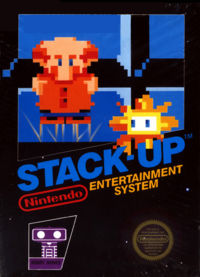Stack-Up

| |
| Stack-Up | |
| Developer | Nintendo R&D1 |
| Publisher | Nintendo |
| System | NES |
| Release Date | NES JP: July 26, 1985 US: October 18, 1985 |
Stack-Up is a puzzle game for the NES. It requires a R.O.B. to play. It's called Robot Block in Japan. The game is considered to be one of the rarest NES games; not many people bought it.
Gameplay[edit]
The game has several different modes.
In Test Mode, the television sends signals to your R.O.B. to make sure it's working properly.
In Direct Mode, the player is given a certain pattern. The player then directs R.O.B. to make him stack his blocks in the same pattern. The score is calculated based on the time and number of moves it took to get the pattern correct. Play continues until R.O.B. drops a block.
Memory Mode is similar to Direct Mode. The difference is that the player must enter all of their commands before they begin. Once the player is done, he goes through all of the commands himself.
In Bingo Mode, players must put blocks in a certain arrangement, but color is irrelevant. The difficulty comes from the way the player controls R.O.B. Using Professor Hector, the player must get a "bingo" for the command they want to use. An enemy named Spike sends the player back to where he began. Flipper also has this affect, but also changes the color of every space he touches. The can result in unwanted commands.
The two-player Bingo Mode is similar two one player. The second player controls Professor Vector and tries to get blocks to the right side of R.O.B. while the first player tries to get them to the left.
Legacy[edit]
Professor Hector makes an appearance in Kirby's Dream Land 3. He gives Kirby a Heart Star if he retrieves all the pieces of R.O.B. Also, Professor Hector walks around the bottom of the main menus in Tetris DS. One of 9-Volt's games in WarioWare, Inc.: Mega Microgame$! is based on Stack-Up and R.O.B.'s Stack-Up blocks appear in Pikmin 2.